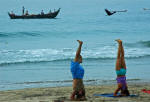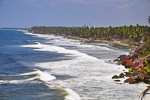Kerala, India. Click on thumbnails below for additional pictures ...
Kerala is known for its long tradition of religious amity, high literacy rate, high social status of women (due in part to its former matrilineal system), and a relatively decent public health service. In 1957, it democratically elected the first communist government in the world. Owing to its high population density, long exposure to foreigners, and a mercantile spirit, lots of Keralites travel abroad for work, most to the Middle East. Hindus, with their diverse sects and practices, form the majority. Christians, over a third of the population, belong to the Orthodox Syrian, Roman Catholic, and Protestant churches. While Muslims reside throughout the state, the Mapillas of the Malabar Coast constitute Kerala's largest Islamic community. Jains live mainly in the far north. The Jewish community remains a small, exclusive sect; there is an ancient synagogue at Cochin.
First mentioned as Keralaputra in a 3rd-century-BCE rock inscription of Ashoka, the region was famous among the Greeks and Romans for its spices (esp. pepper). During the first five centuries CE, it was a part of Tamilakam, and so partially controlled by the eastern Pandyas, Cholas, and Cheras. In the 1st century CE, Jews arrived and St. Thomas the Apostle visited (or so the Syrian Orthodox Christians believe). Arab traders introduced Islam in the 8th century. Under the Kulaśekharas (c. 800-1102), Malayalam emerged as a distinct language and Hinduism became prominent. The Cholas often controlled Kerala in the 11-12th centuries. Ravi Varma Kulaśekhara of Venad briefly ruled southern India in early 14th century. After his death, Kerala became a conglomeration of warring chieftaincies, among whom the most important were Calicut in the north and Venad in the south.
The era of European intervention began in 1498, when Vasco da Gama landed near Calicut. The Portuguese superseded the Arabs to dominate the commerce of Malabar. Their attempt to establish sovereignty was thwarted by the zamorin (hereditary ruler) of Calicut. The Dutch ousted the Portuguese in the 17th century. Martanda Varma ascended the Venad throne in 1729 and crushed Dutch expansionist designs at the Battle of Kolachel. He adopted a European mode of martial discipline, expanded the new southern state of Travancore, and allied with the central state of Cochin (against the zamorin). By 1806, however, Cochin and Travancore, as well as Malabar in the north, had become subject states under the British Madras Presidency. In 1949, Cochin and Travancore were united as Travancore-Cochin state. Today's Kerala was constituted on a linguistic basis in 1956.
Tamil and Sanskrit literature flourished from the 2nd cent. CE. Malayalam, an offshoot of Tamil, absorbed a good deal of Sanskrit and has a prolific literature. Notable Malayali poets include T Eluttaccan and K Nampiyar (classical), and K Asan and Vallathol (modern). In 1889 Chandu Menon wrote Indulekha, the first major novel in Malayalam. Traditional dances in Kerala honor Hindu deities or depict scenes from the great Indian epics. In kathakali, the classical martial dance form of Kerala, males portray both male and female characters. Other Malayali writers and artists include TS Pillai, MT Vasudevan Nair, OV Vijayan, Kamala Das, Arundhati Roy, S Tharoor, P Zacharia, and Raja Ravi Varma. Famous entertainers and sportspeople include Adoor Gopalakrishnan, Yesudas, John Abraham, M. Night Shyamalan, the Sarabhais, Shankar (the cartoonist), PT Usha, and Jimmy George. ♣ [- Jan 06]
 |
 |
 |
|
 |
 |
Designed in collaboration with Vitalect, Inc. All rights reserved. |









